Well-Posedness and Numerical Study for Solutions of a Parabolic Equation with Variable-Exponent Nonlinearities
Abstract
We consider the following nonlinear parabolic equation: ut − div(|∇u|p(x)−2∇u) = f(x, t), where and the exponent of nonlinearity p(·) are given functions. By using a nonlinear operator theory, we prove the existence and uniqueness of weak solutions under suitable assumptions. We also give a two-dimensional numerical example to illustrate the decay of solutions.
1. Introduction
The study of partial differential equations involving variable-exponent nonlinearities has attracted the attention of researchers in recent years. The interest in studying such problems is stimulated and motivated by their applications in elastic mechanics, fluid dynamics, nonlinear elasticity, electrorheological fluids, and so forth. In particular, parabolic equations involving the p(·)-Laplacian are related to the field of image restoration and electrorheological fluids which are characterized by their ability to change the mechanical properties under the influence of the exterior electromagnetic field. The rigorous study of these physical problems has been facilitated by the development of the Lebesgue and Sobolev spaces with variable exponents.
Equation (P) is a nonlinear diffusion equation which has been used to study image restoration and electrorheological fluids (see [4–11]). In particular, Bendahmane et al. [12] proved the well-posedness of a solution, for L1-data. Akagi and Matsuura [13] gave the well-posedness for L2 initial datum and discussed the long-time behaviour of the solution using the subdifferential calculus approach. In our paper, we give an alternative proof of the well-posedness of (P) which is simpler than that in [13] using a theory of nonlinear evolution equations. In addition, we give a numerical example in 2D to illustrate the decay result obtained in [13].
This paper consists of three sections in addition to the introduction. In Section 2, we recall the definitions of the variable-exponent Lebesgue spaces, Lp(·)(Ω), the Sobolev spaces, W1,p(·)(Ω), as well as some of their properties. We also state, without proof, a proposition to be used in the proof of our main result. In Section 3, we state and prove the well-posedness of solution to our problem. In Section 4, we give a numerical verification of the decay result.
2. Preliminaries
Lemma 1 (Hölder’s inequality [10]). Let p, q, s ≥ 1 be measurable functions defined on Ω such that
Lemma 2 (see [10].)Let p be a measurable function on Ω. Then,
- (a)
‖f‖p(·) ≤ 1 if and only if ϱp(·)(f) ≤ 1;
- (b)
for f ∈ Lp(·)(Ω), if ‖f‖p(·) ≤ 1, then ϱp(·)(f) ≤ ‖f‖p(·); and if ‖f‖p(·) ≥ 1, then ‖f‖p(·) ≤ ϱp(·)(f);
- (c)
‖f‖p(·) ≤ 1 + ϱp(·)(f).
Lemma 4 (see [10].)Let Ω be a bounded domain of and p(·) satisfies (1) and (3), and then
Lemma 5 (see [10].)If , q:Ω → [1, ∞) is a continuous function and
Definition 6 (see [17].)Let V be a separable Banach space and H be a Hilbert space such that V ⊂ H ⊂ V′ with continuous embedding and V is dense in H. Let A:V → V′ be a nonlinear operator.
- (1)
A is said to be monotone if If, in addition, we have
(17)then A is said to be strictly monotone. - (2)
A is said to be bounded, if A(S) is bounded in V′, whenever S is bounded in V.
- (3)
A is said to be hemicontinuous, if the real function
(18)is continuous from to , for any fixed u, v, w ∈ V.
We end this section with a proposition which is exactly like Theorem 7.1 [17].
Proposition 7. Let u0 ∈ H and . Suppose that A: V → V′ is a bounded monotone and hemicontinuous (nonlinear) operator satisfying, for some α, β > 0 and for some p > 1,
3. Well-Posedness
In this section, we state and prove the well-posedness of our problem.
Theorem 8. Let . Assume that (1) and (3) hold. Then (P) has a unique weak solution:
Proof. We verify the conditions of Proposition 7. Let , and equip it with the norm,
If M ≤ 1, then Lemma 2 implies ϱp(·)(∇u) ≤ 1 and (29) gives .
If M > 1, then . Thus, (29) implies .
Hence A is bounded.
Monotonicity of A. Let u, v ∈ V. Then
Hence, A is monotone.
To verify (19), we note that, for all u ∈ V, we have
If ‖u‖V = ‖∇u‖p(·) ≤ 1, then by Lemma 2, we obtain
Therefore, conditions of Proposition 7 are satisfied and problem (P) has a unique solution.
4. Numerical Study
Proposition 9 (see [13].)Assume that (1) and (3) hold. Then the solution of (P∗) satisfies the following:
- (i)
If p2 = 2, then there exists a constant c2 > 0 such that
(42) - (ii)
If p2 > 2, there exists a constant c1 > 0 and t1 ≥ 0 such that
(43)
We consider two applications to illustrate numerically an exponential decay for the case p(x, y) = 2 and a polynomial decay for an exponent function p(·) satisfying conditions (1)–(3).
For this purpose, we introduce a numerical scheme for (P∗), prove its convergence in Section 4.1, and show the decay results in Section 4.2.
4.1. Numerical Method
In this part, we present a linearized numerical scheme to obtain the numerical results of the system (P∗) and confirm the decay results. The system is fully discretized through a finite difference method for the time variable and a finite element Galerkin method for the space variable. Useful background about the numerical and error analysis of these methods is found in [18]. More interestingly in [19], Li and Wang introduced a numerical scheme to solve strongly nonlinear parabolic systems and proved unconditional error estimates of the scheme. Our problem (P∗) is highly nonlinear due to the presence of the gradient and nonlinear exponent in the diffusivity coefficient, which can be zero inside the spatial domain. Below, we introduce our numerical scheme for the purpose of confirming the decay results.
Full-Discrete Problem. The variable un+1 is discretized in space by a finite element method. For this, let Ωh be a triangulation of Ω with a maximal element size h. Let also vh be a test function in the linear Lagrangian space P1(Ωh) such that vh = 0 on ∂Ωh.
4.2. Numerical Results
- (1)
Exponential decay: for ph(x, y) = 2, we show, for some c > 0, that
(51) - (2)
Polynomial decay: for ph(x, y) = (1/5)⌈x⌉2 + 2.5, we show, for some c > 0 and t0 > 0, that
(52)Here, ⌈·⌉ denote the greatest integer function.
Figure 1 shows the mesh used for Ωh, which involves 23702 triangles and 12052 vertices.
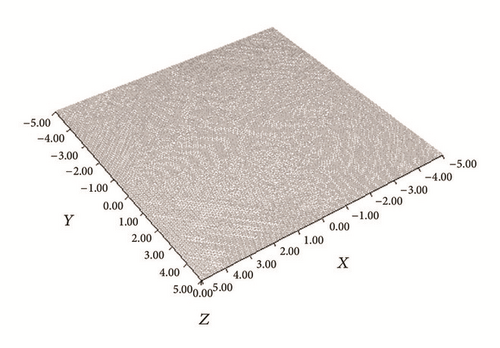
The initial condition is taken to be and projected into P1(Ωh); see Figure 2.

The numerical results are obtained using the noncommercial software, FreeFem++ [21].
Application 1. ph(x, y) = 2 satisfies the required conditions (1)–(3). Figure 3 shows the numerical solutions for t = 5, t = 10, t = 20, and t = 50.
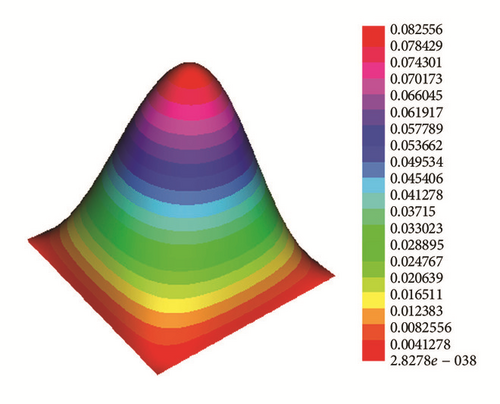
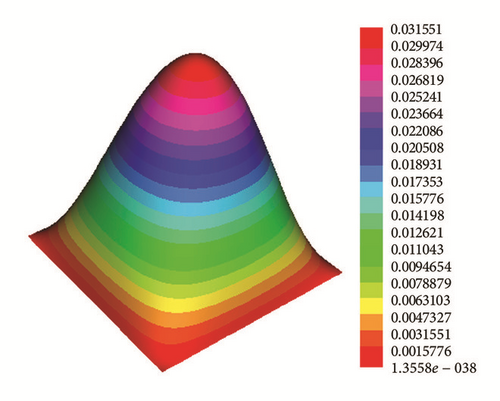
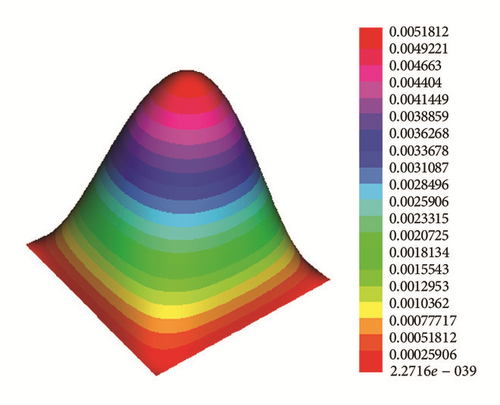
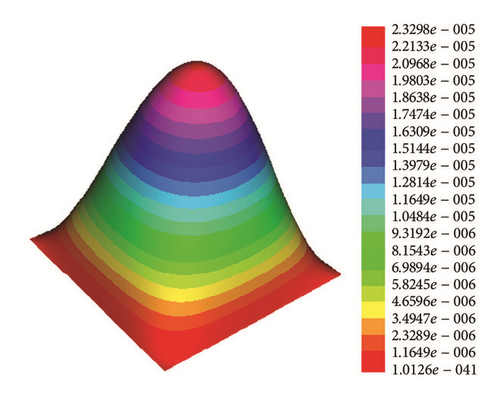
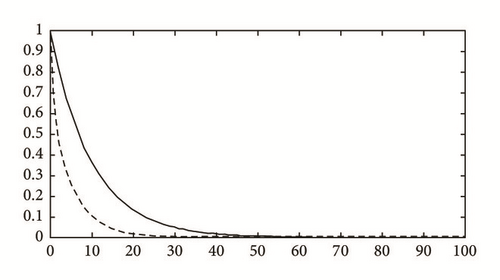

This is also confirmed by Figure 4(b) that shows the ratio y = g1(t)/e−0.1t is less than one and remains decreasing for a large value of T.
Application 2. The exponent function ph(x, y) = (1/5)⌈x⌉2 + 2.5, in Figure 5, satisfies the required conditions (1)–(3) as
- (i)
p1 = 2.5, p2 = 7.5;
- (ii)
for |x − y | < δ with 0 < δ < 1.
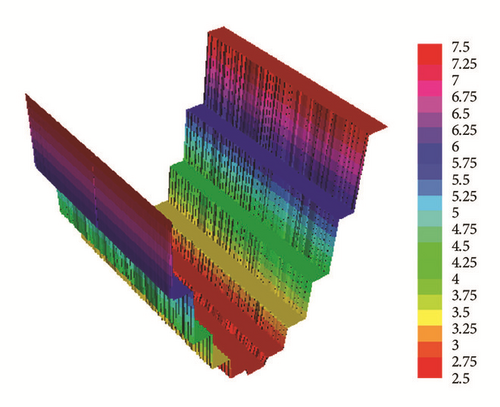
Figure 6 shows the numerical solutions for t = 5, t = 10, t = 20, and t = 50.
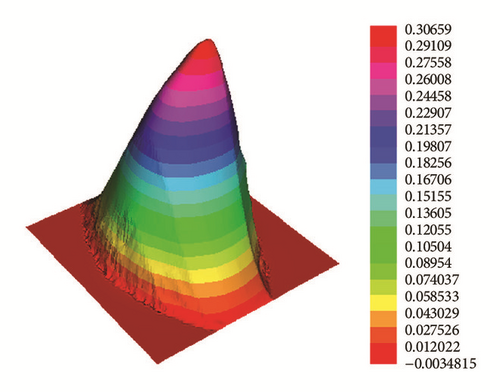

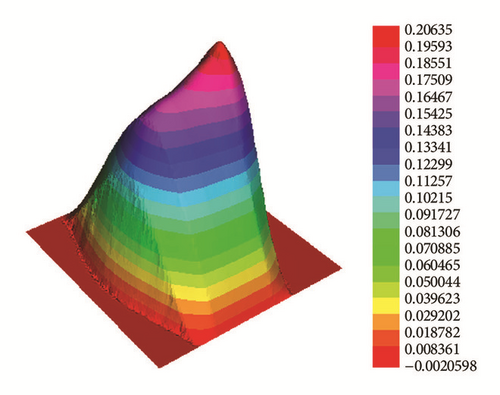
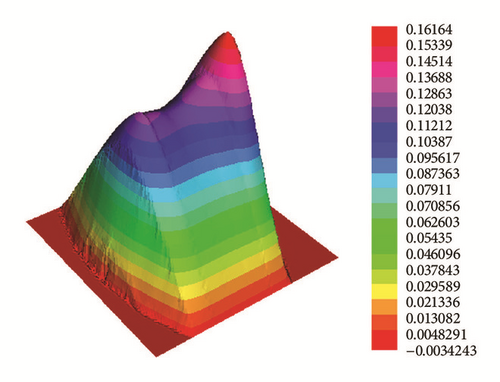
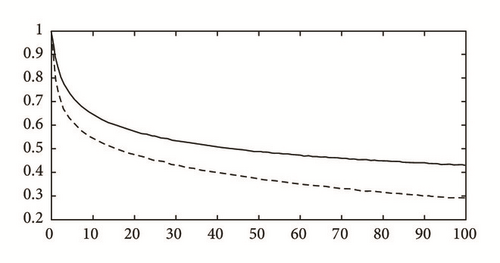
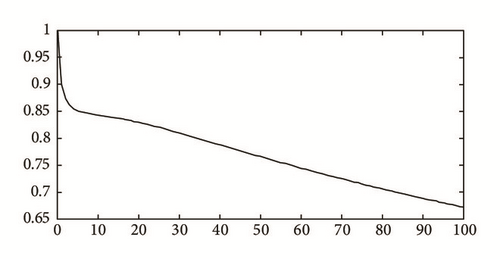
We conclude that the numerical results in above applications verify Proposition 9.
Conflicts of Interest
The authors declare that they have no conflicts of interest.
Acknowledgments
The authors acknowledge King Fahd University of Petroleum and Minerals for its support. This work is sponsored by KFUPM under Project no. FT 161004.




